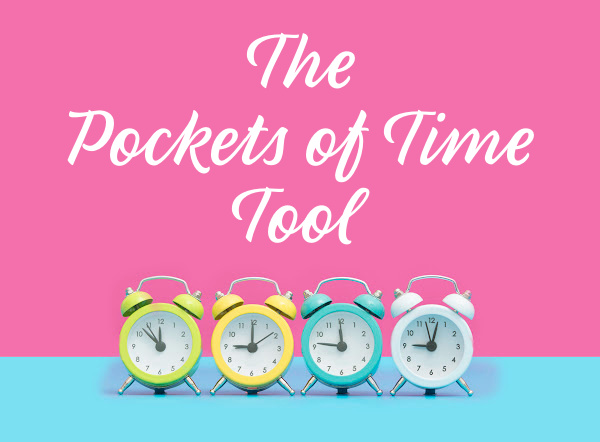Action Tool #2 – The Pockets of Time Tool
The idea for this tool comes from my friend Christina Wiley, author of Juggling Real Food and Real Life, who talks about using “pockets of time” – 15 minutes here, 20 minutes there – to prep real food for healthy meals.
I love that idea, and I also love the fact that you can use this tool to get started and keep going on just about any goal or project that’s important to you.

For example, you could use the Pockets of Time Tool to make progress on:
- Getting into a regular exercise routine
- Eating a healthier diet
- Starting a project that seems overwhelming
- Starting a side hustle
- Taking a class
- Writing a book
In fact, the Pockets of Time Tool can help you make progress on just about any healthy or positive change you want to make, especially the ones that never seem to end up on your to-do list, because other responsibilities keep getting in the way.
Here’s how to use it –
First, start by identifying short periods of “down time” in your schedule – brief periods (generally 10 – 30 minutes) when you sometimes find that you’re not doing anything productive. These are your “pockets of time.” They can include things like waiting in a doctor’s office, waiting to pick up your children, waiting for a friend, taking your lunch hour at work, waiting on hold, scrolling social media, watching a mindless TV show, or other similar periods.
Second, figure out how to put those periods of time to work for you. The specifics of how to use your pockets of time will depend on what you’re trying to do. For example, the things you can do will differ if you’re trying to start exercising regularly vs. if you’re trying to start a side hustle. And they’ll differ if you’re working on eating healthier vs. if you’re taking a class so that you can change careers. But you can use those times to your advantage, regardless of the change you’re trying to make or the goal you’re trying to achieve.
Third, take steps that will make it easier for you to use your pockets of time whenever and wherever they occur. This will typically mean getting some things organized and putting them in strategic places so that you’ll have them when you need them. For example, you might put a pair of walking shoes in your car, so that you can get some exercise while you’re waiting to pick up your children.
Or you might keep a bag with some of your school work or side hustle research in your car, so that you can work on it while you wait in a doctor’s office. Again, the steps you take will depend on your goal and on the times and places when you’re likely to have a bit of down time.
Let’s look at a couple of ways you could use the Pockets of Time Tool. For example, let’s say you want to be more physically active and have set a goal of accumulating 10,000 steps a day on your smart watch or fitness monitor. How can you use your pockets of time to help you achieve that goal?
Start by identifying times when you tend to sit and wait, and use those pockets of time to get up and move. For example, if you work outside your home, use part of your lunch hour to walk. If your children play sports or take music lessons, use their practice or lesson times to walk. If you’re meeting a friend for coffee, walk and talk for at least part of the time. And if you tend to collapse on the couch after dinner and scroll social media or Netflix, take a walk first, maybe with your spouse, one of your children, or a neighbor.
Walking during sports practices was one of my favorite tools when our boys were younger. When they played soccer, I often walked during soccer practice. Some days it gave me an opportunity to enjoy some alone time at the end of a busy day, and other days it gave me a chance to walk and talk with other moms. And when they played basketball, I often walked around the block outside the gym during basketball practice. And I always wore a Fitbit or other activity tracker, because I like to get “credit” for my efforts to be more physically active!
Or, let’s say that you want to start eating healthier and are committed to eating more fruits and vegetables, cooking more meals at home, and eating fewer takeout meals. But you’re finding that doing those things takes more time and effort than you have available.
Fortunately, your pockets of time can help. Start by identifying your “sticking points,” the tasks that get in the way of cooking and eating healthier meals. Those tasks might include making a menu for the week, making a grocery list, finding healthy recipes, keeping your refrigerator and pantry organized, washing and cutting up fruits and vegetables, grating cheese, or cooking chicken breasts or ground beef.
Then figure out how you can use 15 minutes here, 20 minutes there to accomplish those tasks. For example, use the waiting time in a doctor’s office or before a meeting to make a menu for the coming week and start making a grocery list. Or take a few extra minutes when you’re grating cheese or cutting onions for a recipe and grate or cut double the amount you need, then freeze the extra for next time. Or use any waiting time in the kitchen (waiting for pasta water to boil or for something in the oven to finish cooking) to wash or cut up fruits or vegetables, so that they’re ready to use when you need them.
I usually take 20-30 minutes on Sunday night and wash and cut up salad vegetables for the week. That way, when I get home from work on a busy week day, I can make a salad to go with dinner in less than 5 minutes. And I usually take a few minutes on Saturday morning, before the day really gets going, to make a menu of (mostly!) healthy meals and a grocery list for the week.
Use the Tool – Pick one healthy or positive change – the one you’ve most been wanting to tackle but just haven’t had the time. Then make a list of steps you could take or tasks you could complete to move forward on that change. Decide which of those tasks you could do during pockets of time – 10- to 30-minute periods of down time (or time that could be allocated in a new way). Finally, figure out ways to make it easier to use those periods to get things done that facilitate the change you want to make – set timers or calendar prompts to remind you, put the tools you’ll need in places where you can access them easily, set up a routine for doing the same task at the same time every day or week, or anything else that will make it easier for you to use pockets of time to your advantage.
How have you made pockets of time work for you? Or how would you like to start using them? Let me know in the comments – I’d love to hear from you.








This is an excellent suggestion (s). I actually do this and I did a 30 minute walk today at the mall. My daughter can’t drive so I get steps in when I take her to work.
I can use this same strategy when I pick her up when she works late. I can work on planning meals and grocery lists.
Thank you, Rosalyn. I really love this tool. When you start thinking in terms of “where do I have pockets of time,” you start to see lots of possibilities!